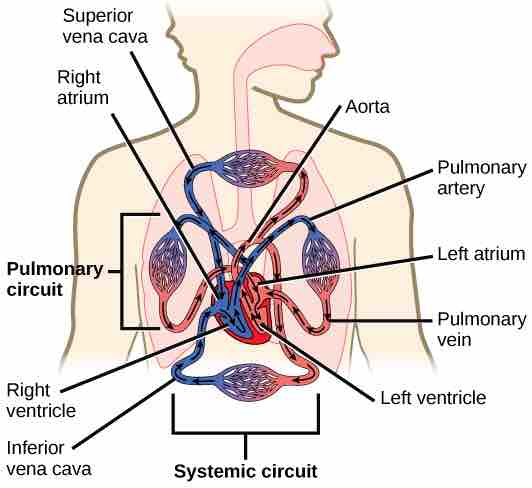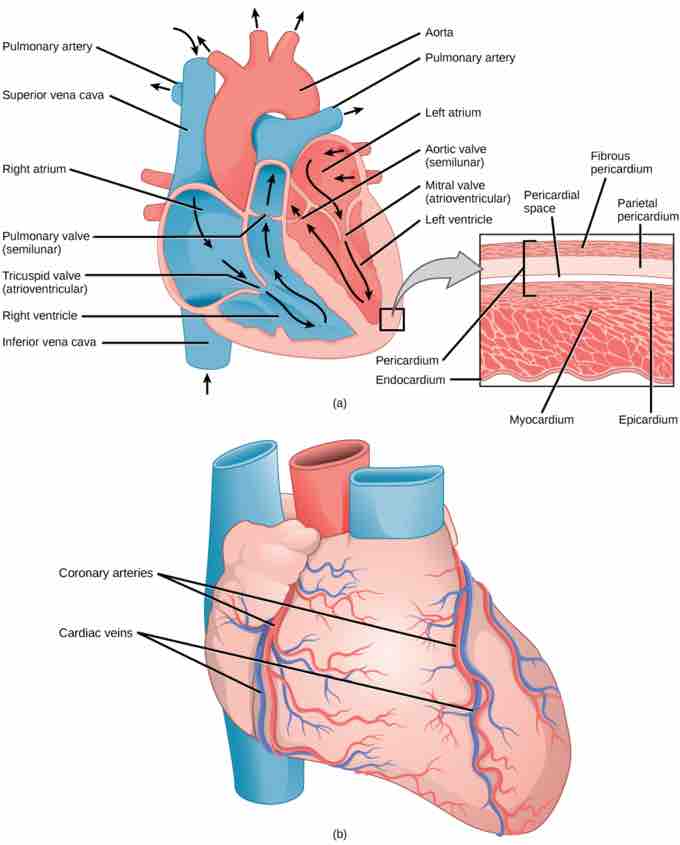Structure of the Heart
The heart is a complex muscle that pumps blood through the three divisions of the circulatory system: the coronary (vessels that serve the heart), pulmonary (heart and lungs), and systemic (systems of the body). Coronary circulation intrinsic to the heart takes blood directly from the main artery (aorta) coming from the heart. For pulmonary and systemic circulation, the heart has to pump blood to the lungs or the rest of the body, respectively .

Circulatory System
The mammalian circulatory system is divided into three circuits: the systemic circuit, the pulmonary circuit, and the coronary circuit. Blood is pumped from veins of the systemic circuit into the right atrium of the heart, then into the right ventricle. Blood then enters the pulmonary circuit and is oxygenated by the lungs. From the pulmonary circuit, blood re-enters the heart through the left atrium. From the left ventricle, blood re-enters the systemic circuit through the aorta and is distributed to the rest of the body. The coronary circuit, which provides blood to the heart, is not shown.
The heart muscle is asymmetrical as a result of the distance blood must travel in the pulmonary and systemic circuits. Since the right side of the heart sends blood to the pulmonary circuit, it is smaller than the left side, which must send blood out to the whole body in the systemic circuit.
In humans, the heart is about the size of a clenched fist. It is divided into four chambers: two atria and two ventricles. There are one atrium and one ventricle on the right side and one atrium and one ventricle on the left side. The atria are the chambers that receive blood while the ventricles are the chambers that pump blood. The right atrium receives deoxygenated blood from the superior vena cava, which drains blood from the veins of the upper organs and arms. The right atrium also receives blood from the inferior vena cava, which drains blood from the veins of the lower organs and legs. In addition, the right atrium receives blood from the coronary sinus, which drains deoxygenated blood from the heart itself. This deoxygenated blood then passes to the right ventricle through the right atrioventricular valve (tricuspid valve), a flap of connective tissue that opens in only one direction to prevent the backflow of blood. After it is filled, the right ventricle pumps the blood through the pulmonary arteries to the lungs for re-oxygenation. After blood passes through the pulmonary arteries, the right semilunar valves close, preventing the blood from flowing backwards into the right ventricle. The left atrium then receives the oxygen-rich blood from the lungs via the pulmonary veins. The valve separating the chambers on the left side of the heart is called the biscuspid or mitral valve (left atrioventricular valve).The blood passes through the bicuspid valve to the left ventricle where it is pumped out through the aorta, the major artery of the body, taking oxygenated blood to the organs and muscles of the body. Once blood is pumped out of the left ventricle and into the aorta, the aortic semilunar valve (or aortic valve) closes, preventing blood from flowing backward into the left ventricle. This pattern of pumping is referred to as double circulation and is found in all mammals.

Human Heart
(a) The heart is primarily made of a thick muscle layer, called the myocardium, surrounded by membranes. One-way valves separate the four chambers. (b) Blood vessels of the coronary system, including the coronary arteries and veins, keep the heart muscles oxygenated.
Layers of the Heart
The heart is composed of three layers: the epicardium, the myocardium, and the endocardium. The inner wall of the heart is lined by the endocardium. The myocardium consists of the heart muscle cells that make up the middle layer and the bulk of the heart wall. The outer layer of cells is called the epicardium, the second layer of which is a membranous layered structure (the pericardium) that surrounds and protects the heart; it allows enough room for vigorous pumping, but also keeps the heart in place, reducing friction between the heart and other structures.
Blood Vessels
The heart has its own blood vessels that supply the heart muscle with blood. The coronary arteries branch from the aorta, surrounding the outer surface of the heart like a crown. They diverge into capillaries where the heart muscle is supplied with oxygen before converging again into the coronary veins to take the deoxygenated blood back to the right atrium, where the blood will be re-oxygenated through the pulmonary circuit.
Atherosclerosis is the blockage of an artery by the buildup of fatty plaques. The heart muscle will die without a steady supply of blood; because of the narrow size of the coronary arteries and their function in serving the heart itself, atherosclerosis can be deadly in these arteries. The slowing of blood flow and subsequent oxygen deprivation can cause severe pain, known as angina. Complete blockage of the arteries will cause myocardial infarction—death of cardiac muscle tissue—which is commonly known as a heart attack.